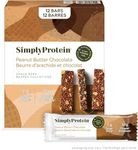Buying Guide for the Best Protein Bars For Diabetics
Choosing the right protein bar as a diabetic is all about balancing nutrition, taste, and how the bar fits into your daily routine. The goal is to find a bar that supports your health, helps manage your blood sugar, and satisfies your hunger or snack cravings. It's important to look beyond marketing claims and focus on the nutritional information, especially the ingredients and how they might affect your blood sugar levels. Always consider how the bar will fit into your overall meal plan and daily carbohydrate allowance.Carbohydrate ContentCarbohydrate content tells you how many grams of carbs are in each bar, which is crucial for blood sugar management. Carbs are the main nutrient that affects blood sugar, so knowing this number helps you plan your meals and snacks. Bars can range from very low-carb (under 10g) to higher-carb (over 25g). If you need to keep your blood sugar stable, look for bars on the lower end, but also consider how the carbs fit into your total daily intake. Choose a bar with a carb count that matches your personal needs and how active you are.
Sugar ContentSugar content shows how much of the carbohydrates come from sugar, which can cause quick spikes in blood sugar. Some bars have added sugars, while others use sugar alcohols or natural sweeteners. Bars with less than 5g of sugar are generally better for blood sugar control. If you are sensitive to sugar spikes, opt for bars with the lowest sugar content, but also check for artificial sweeteners if you prefer to avoid them.
Fiber ContentFiber is a type of carbohydrate that your body doesn't digest, so it doesn't raise blood sugar. High-fiber bars (5g or more per serving) can help slow down the absorption of sugar and keep you feeling full longer. If you want to manage hunger and blood sugar, look for bars with higher fiber content. If you have digestive sensitivities, start with moderate fiber and see how your body reacts.
Protein ContentProtein helps keep you full and supports muscle health, and it doesn't raise blood sugar. Protein bars can range from 5g to over 20g per serving. If you're using the bar as a meal replacement or post-workout snack, aim for higher protein. For a light snack, a moderate amount is enough. Choose the protein level based on your activity level and how filling you want the bar to be.
Fat ContentFat slows down digestion and can help prevent blood sugar spikes, but too much can add extra calories. Bars can be low-fat (under 5g) or high-fat (over 10g). If you want a more filling bar or follow a low-carb, high-fat diet, a higher fat content may be suitable. If you are watching your calorie intake, choose a bar with moderate fat.
Ingredients ListThe ingredients list tells you what is actually in the bar. Look for whole food ingredients like nuts, seeds, and natural sweeteners, and avoid bars with lots of artificial additives or high-fructose corn syrup. If you have allergies or sensitivities, check for common allergens. Choose a bar with ingredients you recognize and feel comfortable eating.
Glycemic Index (GI)The glycemic index measures how quickly a food raises blood sugar. Bars with a low GI are digested more slowly and cause a gentler rise in blood sugar. Not all bars list their GI, but you can estimate it by looking for bars with more fiber, protein, and healthy fats, and less sugar. If you are sensitive to blood sugar swings, aim for bars with a lower GI profile.














